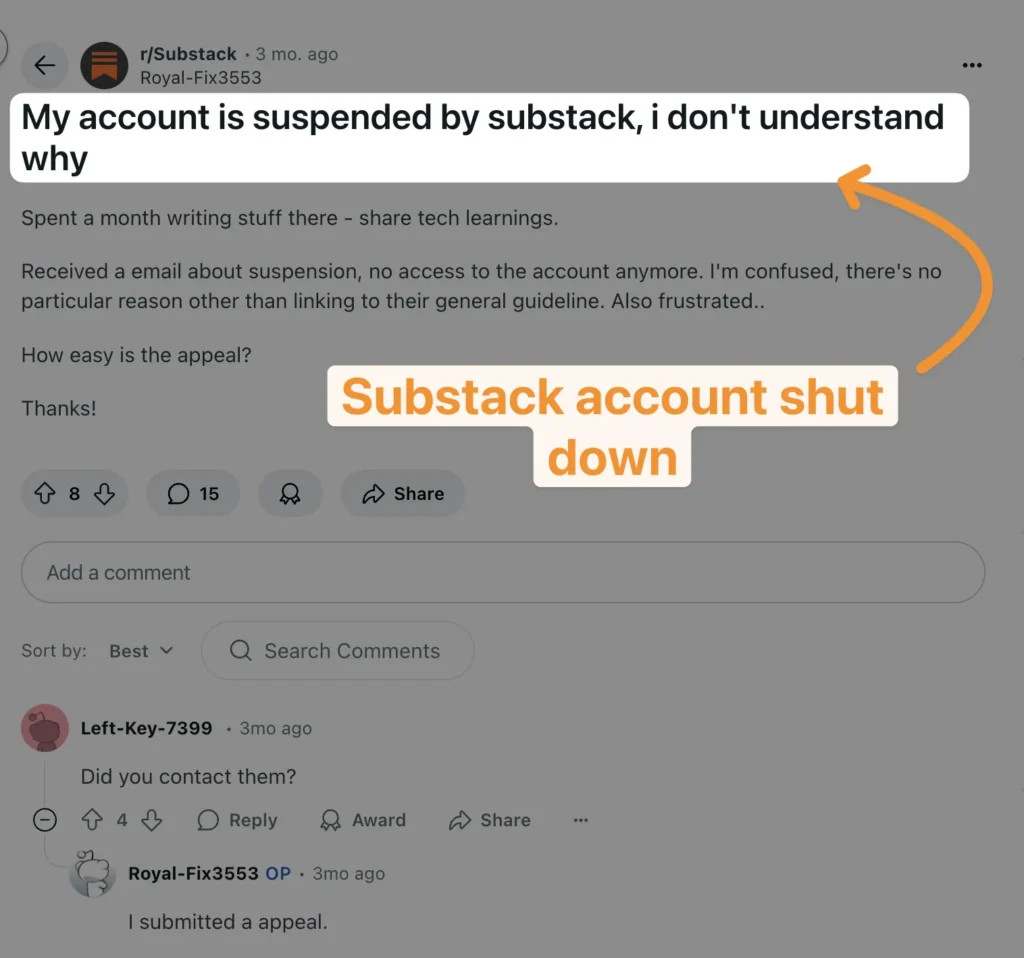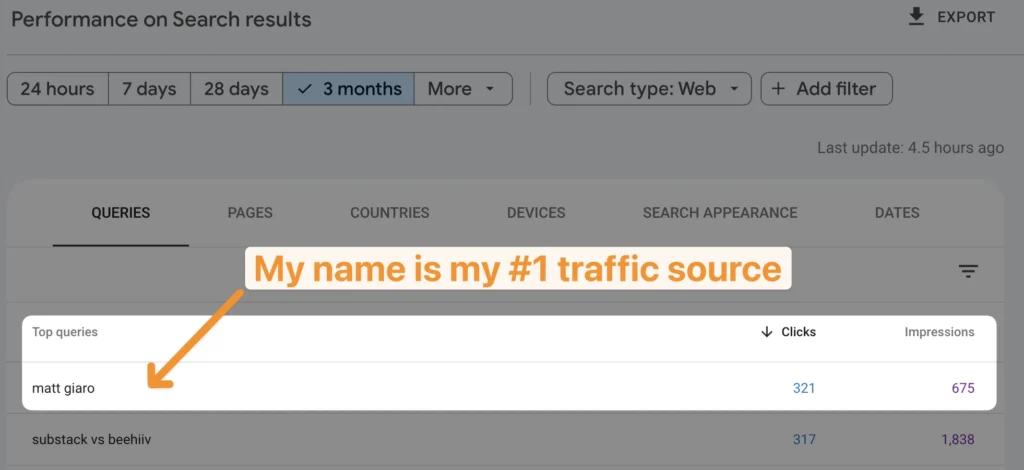Is Substack good for blogging or should you stick to a good ol’ blog?
I’ve been using both.
I started my first WordPress blog in 2011 (and still use my blog today).
And I’m also writing on Substack, and my publication has over 5,000 subscribers:

So here’s my non-BS comparison:
How is Substack Different from a Blog?
The big mistake I see new bloggers make is to think that Substack is the new blog and that having a Substack publication is enough.
But… The reality is that both are radically different.
Substack Is The Newsletter Platform For Writers
Substack was primarily designed as a newsletter platform. Not a blogging platform.
You can consider it a hybrid—a newsletter with the vibe of a social blog.
When people subscribe to your Substack, they are primarily subscribing to your newsletter.
And there are different ways to get people to subscribe to your Substack, they can discover your publication with:
- Podcasts
- Live streams
- Video content
- or Substack Notes, which is the social media component baked into Substack.
Substack doesn’t require you to learn the basics of SEO to get discovered. But it requires you to engage with the community and post social-like content.
Blogging: The Jack of All Trades
Now, contrast that with a blog.
On a blog you could publish your articles, but also host your own online courses, etc.
You can monetize it through different ways:
Ads, sponsored content, selling products or courses, the sky’s the limit.
Your blog can be a one-stop shop, a digital magazine, or even a corporate platform.
You can host webinars, podcasts, or even an e-commerce site.
Can you do all that with Substack? Nah, not even close.
That’s why Substack is different from having a blog on WordPress or Ghost.
The main reason why you also want to use a blog rather than just relying on Substack is that your blog is your own piece of real estate on the internet, which means that nobody can ban you.
I personally got cancelled from Facebook without having done anything against their guidelines. And my Medium account has also been suspended two times, but I was able to get it back.
So don’t tell me that you can’t get cancelled… Because you can.

Building an Audience: Which Is easier?
Blogging on your blog is all about SEO.
And SEO is a long-term game, which means that it takes time to set up, but once it’s working, it brings you traffic for years to come.
The other interesting thing about SEO is that it doesn’t require you to interact with others. So this is one of my favorite ways, because I’m an introvert.
Writing blog posts for SEO in a nutshell is very simple (in theory):
You need to identify keywords, and then you simply need to produce the best piece of the internet around that keyword.
Now, SEO may sound like rocket science or too competitive to some.
It’s not.
There are still ways to make SEO writing simple and rank new blogs on Google.
I did it with this website. I do it with client websites.
But keep in mind that to get a new blog off the ground, you would need to stick at least to writing consistently about your expertise for the next three to six months.
On Substack you might witness faster growth if you know and stick to the right playbook.
On Substack, keep in mind the algorithm side of things. Don’t be surprised if you feel like being on a content treadmill having to produce new content all the time to stay relevant.
However, one of the interesting features Substack offers is the fact that other subscribers can recommend your newsletter to others. Think of it as a free referral program. Now, you can’t have this on your blog.
Either you rank, or you don’t.
Overall, building an audience on Substack might be easier in the short run, but having a blog is better in the long run because you’ll benefit from SEO.
Cost: Which is cheaper?
A self-hosted WordPress blog will cost more than a free Substack account.
Prices start around $10/month for a self-hosted WordPress blog with a domain (that’s what you want to go for.)
Substack is free.
Substack only takes a 10% cut when someone subscribes to your paid newsletter.
(Yes, Substack allows you to run a free newsletter or a paid one.)
If you only plan to write free emails, Substack won’t cost you a dime.
Customization: Blog vs. Substack
Blog (or WordPress): A Buffet of Options
Your blog is your piece of digital real estate on the internet.
You can do whatever you want on it.
Take WordPress as an example
It’s like your local artisanal market, a place where you can handpick every single detail to fit your style, your voice, and your brand.
Ever walked into one of those gourmet burger joints where you can build your own burger? You choose the bun, the patty, the toppings—heck, even the type of mayo.
That’s WordPress for you. Each plugin and each theme is an ingredient that makes your site uniquely yours.
For example, imagine you’re building a course on “Time Management for Experienced Professionals.”
With WordPress, you can add a forum plugin for students to discuss topics, embed YouTube tutorials, and integrate a payment gateway for quick enrollments.
Want to give a quiz at the end of each module? There’s a plugin for that.
Your blog becomes this dynamic, interactive learning hub – not just a place to publish articles.
Substack: Cookie-Cutter Experience
Substack is more like a fast-food drive-thru. It’s like buying a model home—everything comes pre-installed, and there’s not much room to change anything. Ever try to get “just a little extra sauce” at a fast-food joint? Good luck.
Now, Substack isn’t completely rigid.
Think of it as a classic diner menu. You can pick your type of burger—chicken, beef, or veggie—but you can’t choose the type of cheese or add pineapple on top. For instance, Substack lets you pick a template, tweak the colors, and add your logo.
That’s not too shabby, right?
You can even decide how to structure your newsletter, opting for sections or sticking to long-form articles. It’s customization but within guardrails.
However, it’s also not where you go for a five-course gourmet meal. Say you’re doing a deep dive into cryptocurrency for beginners. Sure, you can serialize it over several newsletters. But could you add a live feed of current crypto prices? Or a forum for community discussions? Nope, you’re out of luck.
Substack offers a more streamlined experience with limited customization options. While users can customize the look and feel of their newsletter using customizable templates, there aren’t many functionality options beyond the basic features.
Blogs like WordPress offer limitless possibilities, while Substack gives you a neat, predetermined package.
Alright, let’s get to the nitty-gritty of set-up and ease of use. Sometimes it’s not just about what you can do; it’s about how easily you can do it.
Set Up and Ease of Use
Blogging: Easier Than You Think
The myth that setting up a blog is a Herculean task needs to be busted.
Let’s get real.
We’re not in 1999 anymore.
You’re not hand-coding HTML in Notepad.
These days, setting up a WordPress blog is as easy as assembling a piece of IKEA furniture. You know, the kind with just three steps in the manual?
Host providers give you 1-click installations, and there are more “how-to” guides than there are Starbucks in Seattle.
Picture this: You’re an experienced marketing exec who wants to launch a blog about branding.
Years ago, you’d dread the setup process, right?
Now, you click a few buttons, and your website is up and running faster than you can make a cup of coffee.
You didn’t even break a sweat.
Substack: Easy Peasy Lemon Squeezy
Now, where Substack really shines is in its utter simplicity.
Imagine you’re at a fast-food restaurant. You don’t worry about how they make the fries; you’re just glad they’re hot and crispy when you get ’em.
Substack is that fast-food chain.
You’re not fussing over plugins or themes. You simply type and hit ‘Publish’. It’s clean, it’s streamlined, and you can’t mess it up.
Literally, you can’t, because there aren’t that many knobs to turn.
Where Substack saves you time: It’s optimized.
No decisions to make. It’s the same layout for everyone.
Less decision-making means more time for content creation. In our fast-paced lives, who wouldn’t want to save a few precious minutes?
After all, you could use that time to perfect your next killer strategy, couldn’t you?
To wrap this up: Substack might be easier, but installing a blog right now isn’t harder.
With all the one-click installations and tutorials, setting up a blog is a piece of cake.
Where Substack saves you time is in the optimization—fewer decisions mean you hit the ground running.
Email marketing features
If you plan to use a WordPress blog, you’ll definitely add an autoresponder to the mix to gather email subscribers.
Because this is what the blogging game is all about.
There are myriad autoresponders you can choose from like Beehiiv or MailerLite.
Most people turn to Substack because it allows you to send free emails.
But what many don’t realize is that Substack lacks of features that autoresponders offer.
Like:
- Being able to tag your subscribers based on interest
- Send welcome sequences
- and more…
In short, you’ll still need to use an email marketing autoresponder to really take your email marketing to the next level.
Conclusion: Substack vs. Blog
Substack will never replace your own personal blog.
I always recommend creators to think long-term and have their own blog to benefit from SEO & LLM search.
Because let’s face it people are still searching for your name on Google:

How would you react if you stumbled across someone who doesn’t even have a website?
Substack, though, is a great platform to grow your newsletter audience and find your target audience thanks to their recommendation features and algorithm.
In short: Use both.
Frequently Asked Questions Around Substack For Blogging
Can Substack Be Used as a Blog?
Yes, but you’ll lack all the different personalization components.
And you will not be able to create different pages for your services or courses. There are workarounds, but it’s not the best choice.
Does Substack own your content?
Legally, Substack does not own your content.
But in practice, if you take into consideration that you can not add a canonical URL to your content that points back to your blog.
So if you decide to delete your content (or get banned), then everything is gone unless you have a backup.
Can You Use Medium Posts on Substack?
You can.
However, it might mess up the SEO since Google will handle one of those as duplicate content.
The workaround: Publish on Substack first, and then add your Substack URL as canonical on Medium.
How to Use Substack and WordPress Together?
If you want to use Substack and WordPress together, then I recommend using Substack as a discovery platform where you publish your newsletters and WordPress where you publish your SEO-optimized articles.
You can also embed the Substack opt-in forms on your WordPress blog to gather subscribers. In that way, you get the best out of both worlds.
Is Substack the New Blog?
No, it’s not.
You could think of Substack as the new Medium, but not as a blog.
The reason is that Substack lacks essential SEO features to be considered as a new blog platform.
Why use Substack instead of a blog?
Substack is great if you have no prior SEO experience.
You can tap into a pool of hungry readers by starting to write on Substack.
